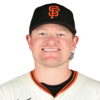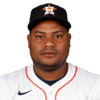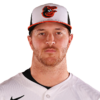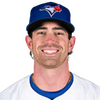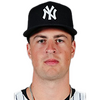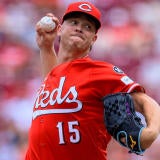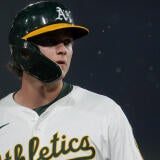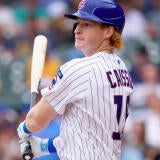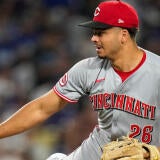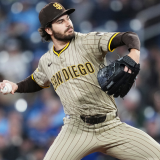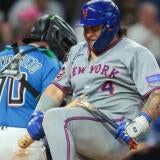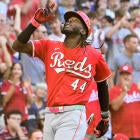Early 2026 Fantasy Baseball Rankings: Top 40 at starting pitcher gives priority to biggest bat-missers
How deep it is depends on how much grace you give to recent injury cases
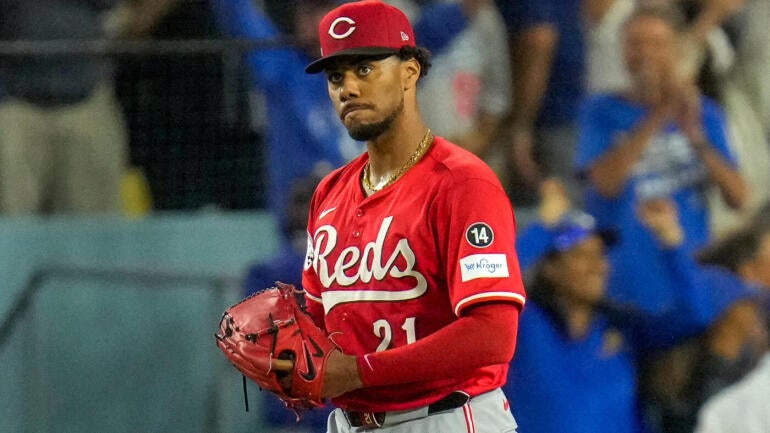
Can we tell which starting pitchers are going to get injured? Do we have any sort of reliable metric for that?
Sure, past injury can be a predictor of future injury, but it's not a particularly good one. We sometimes treat it as foolproof. Zack Wheeler, Logan Gilbert and George Kirby were some of the safest bets to make it through the 2025 season unscathed, but they didn't. Bryan Woo and Jacob deGrom were supposed to have no chance of remaining healthy, but they did.
The pitching motion is an unnatural one, and done with the repetition and force required to succeed at the major league level, it's only a matter of time before injury is the result. So is predicting when and where one will arise a fool's errand? Should we even bother to try?
More and more, I'm beginning to doubt that. Surely, durability counts for something. A perpetual injury case like Tyler Glasnow can only be trusted to do so much, and there's of course a big difference between a pitcher who goes 6-7 innings with regularity and one who never does. But when evaluating pitchers for a new season, effectiveness should be the primary and secondary consideration, with demerits for durability applied in only the most extreme cases.
With that, here's my initial top 40 for 2026.
Note that the focus here is standard 5x5 scoring (such as Rotisserie leagues), but if you scroll a little further, you'll see my rankings for points leagues.
| 1 |
Tarik Skubal
Detroit Tigers SP
|
| With a reputation as the best starting pitcher in baseball after back-to-back Cy Young-caliber seasons, Skubal is the obvious choice to go No. 1 in Fantasy Baseball and is the first starting pitcher in several years that I would consider drafting in the first round of a 12-team league. | |
| 2 |
Garrett Crochet
Boston Red Sox SP
|
| Crochet is 1A to Skubal's 1, particularly now that he's proven he can take on an ace workload, and he might even have a slight edge on Skubal with regard to strikeouts. The biggest difference between the two is that Skubal has done twice what Crochet has done only once, foreseeable though it was, but I'd be willing to spend a late first-rounder on either one. | |
| 3 |
Paul Skenes
Pittsburgh Pirates SP
|
| Skenes rounds out the top tier at this position, looking every bit as bankable as Skubal and Crochet after delivering back-to-back seasons with an ERA below 2.00. He comes in a hair short of those two in strikeouts and has the great misfortune of pitching for a miserable Pirates team that suppresses his wins total. | |
| 4 |
Chris Sale
Atlanta Braves SP
|
| Though he's a distant No. 4 in these rankings, Sale seemed like he might cruise to his second Cy Young award before fracturing his rib on a diving stop in mid-June. He struck out exactly nine in five of his six starts after returning from the injury, looking just as much like the ace he was before it, but he has had trouble staying healthy over the years and will be turning 37. | |
| 5 |
Yoshinobu Yamamoto
Los Angeles Dodgers SP
|
| Yamamoto had a much healthier second season in the States and was every bit the ace he was billed to be, routinely working seven innings or more while recording double-digit strikeouts five times. The biggest knock on him is that he'll be working out of a six-man rotation most of the time, which may cost him four starts or so over the course of the year. | |
| 6 |
Logan Gilbert
Seattle Mariners SP
|
| Gilbert's workhorse reputation took a hit when he was sidelined for seven weeks by a flexor strain early in the year. Even after he returned, his starts tended to run on the shorter side, but he did make a leap as a bat-misser with a better K/9 rate (11.9) than both Skubal and Crochet. Clearly, there's a lot to like here. It's just hard to say what shape it'll take. | |
| 7 |
Cristopher Sanchez
Philadelphia Phillies SP
|
| Sanchez's rapid ascent broke through the stratosphere in 2025 as he finally managed to sustain peak velocities without compromising his elite strike-throwing ability. Combined with his penchant for ground balls, he now excels in all three of the areas that we've traditionally known a pitcher to have the most control over, and he worked more than six innings in half of his 32 starts. Sounds like an ace to me. | |
| 8 |
Bryan Woo
Seattle Mariners SP
|
| Known just as much for his brittleness as his efficiency heading into 2025, Woo emerged as a bona fide workhorse, being one of just 13 pitchers to throw 185-plus innings, and was arguably the ace of a loaded Mariners pitching staff. He did develop a pectoral issue late in the year that impacted his availability for the playoffs, but we know now that he's not some delicate flower who won't be able to follow through on his considerable talents, which are headlined by pristine control. | |
| 9 |
Max Fried
New York Yankees SP
|
| Fried cooked in his first year with the Yankees , setting career highs for wins, innings and strikeouts while delivering a sub-3.00 ERA for the third time in four years. He can get a little lost in his six-pitch arsenal sometimes, as seemed to happen during a bumpy eight-start stretch midseason, and he isn't the biggest source of strikeouts. But now that he's answered the durability question, he's as bankable as it gets for ERA. | |
| 10 |
Hunter Brown
Houston Astros SP
|
| Brown isn't as good of a bat-misser as his 10.0 K/9 would have you believe, and indeed, that number dropped to 8.8 in the second half. But his ERA was exactly as good (2.43) in the second half because he excels at inducing weak contact on the ground. He's an ace in much the way Fried is, so it's fitting that they rank side by side. | |
| 11 |
Hunter Greene
Cincinnati Reds SP
|
| Greene might rank as high as fourth if there was reason to believe that his arm could hold up to 180 innings, but as the hardest-throwing starting pitcher in baseball (averaging 99.5 mph on his fastball in 2025), he has yet to come close. Of course, his time lost in 2025 was due to a groin injury, and for the time he was healthy, he showed himself to be a definitive ace, confirming his stud turn from a year earlier. | |
| 12 |
Cole Ragans
Kansas City Royals SP
|
| The guess here is that Ragans will be a tough sell for many given that he missed most of 2025 with a strained rotator cuff and ended up delivering just a 4.67 ERA. But the small sample is responsible for the outlandish ERA, which is betrayed by some jaw-dropping strikeout numbers that reveal him to be, in no uncertain terms, an ace of the highest standing. Twelfth may be too low, honestly. | |
| 13 |
Blake Snell
Los Angeles Dodgers SP
|
| The book on Snell is that he's both frustratingly inconsistent and all too frequently injured, but we should at least be able to put the first of those ideas to rest, seeing as he has a 2.76 ERA, 1.17 WHIP and 11.8 K/9 over the past four seasons. As for the health concern, how does that distinguish him from the two ahead of him and the two behind him in these rankings? | |
| 14 |
Jacob deGrom
Texas Rangers SP
|
| For as rudimentary as it seemed, taking a little off the fastball really did allow deGrom to stay healthy for the first time since 2020 -- and without costing him much in the way of effectiveness, which is understandable given that he was winning Cy Youngs at those reduced velocities. At 37, he's not as dominant as he once was and will probably never be a workhorse again, but at least we can draft him with some conviction. | |
| 15 |
Spencer Schwellenbach
Atlanta Braves SP
|
| Schwellenbach was very much breaking through as an ace when his elbow itself broke while delivering a pitch in late June. It may be that his arm can't hold up to the higher velocities he was reaching, a possibility that he himself has acknowledged, which raises the question of how dominant he'll be if he takes a little off. But he was just as good with slightly less velocity as a rookie in 2024, thriving on elite control and a deep arsenal. | |
| 16 |
Jesus Luzardo
Philadelphia Phillies SP
|
| If this seems high for Luzardo, note that season numbers were skewed by a two-start stretch in which he was obviously tipping his pitches. If you take those away, he's left with a 3.03 ERA, 1.11 WHIP and 10.6 K/9 -- numbers that are more befitting of the 16th-ranked starting pitcher and that, frankly, are more in line with his ERA estimators. He was top 10 for xERA, FIP, and xFIP. | |
| 17 |
Logan Webb
San Francisco Giants SP
|
| Webb is the first of these pitchers who rates significantly better for points leagues, being an established workhorse who just put together his third straight season with 200-plus innings, but for the second straight year, his WHIP was actively harmful in Rotisserie. He was particularly hittable in the second half, struggling with the consistency of his changeup. | |
| 18 |
Framber Valdez
Houston Astros SP
|
| Like Webb, Valdez is an established innings eater, which goes a long way toward smoothing out his rough edges in Head-to-Head points, but it's trickier in 5x5 leagues. The past couple years have shown that he can hang with any ace when his curveball is in peak form, but he's increasingly vulnerable when it isn't. On balance, you should expect the ERA and WHIP to run a little hot. | |
| 19 |
Freddy Peralta
Milwaukee Brewers SP
|
| Peralta just gave us his best-case scenario with a 2.70 ERA, which was about a run lower than the previous three years even though all of his peripherals remained the same. Without a substantive improvement in strikeout or walk rate, or a transition from being a fly-ball pitcher to a ground-ball pitcher, I'm inclined to think he'll regress to the mean, which would justify a pick this high but no higher. | |
| 20 |
George Kirby
Seattle Mariners SP
|
| Kirby's 2025 began with an IL stint, the first of his career, for shoulder soreness and remained off-kilter from there. There were some high highs, such as two 14-strikeout efforts, but enough lows that his ERA swelled to 4.21 even though there were no obvious signs of decline. Maybe he never quite felt right. Maybe he got a little too cute with his pitch selection. Whatever the case, he'll be drafted with some trepidation in 2026. | |
| 21 |
Tyler Glasnow
Los Angeles Dodgers SP
|
| Now well into his 30s, Glasnow still has yet to reach even 140 innings in a season, this time missing more than two months with shoulder inflammation. He basically pitched like an ace after returning, though, which is why we can only discount him so much for the injuries. I say "basically" because he does have a penchant for hard contact, which causes the ERA to run a little high. | |
| 22 |
Kyle Bradish
Baltimore Orioles SP
|
| Bradish placed fourth in AL Cy Young voting in 2023 and was looking even better before succumbing to Tommy John surgery in 2025, so it's surprising that his return last August didn't generate more enthusiasm. Even here, I may be underselling a guy whose 2.53 ERA, 1.03 WHIP, 13.2 K/9 and 14.6 percent swinging-strike rate would have all ranked in the top 10 if he had contributed them over a full season rather than just six starts. | |
| 23 |
Eury Perez
Miami Marlins SP
|
| Perez ran hot and cold during his first season back from Tommy John surgery, which spanned 20 starts, but through it all, he demonstrated the same arsenal of swing-and-miss offerings that made him a rookie sensation in 2023. If you thought he had ace upside then, he's no further from delivering on it now even though the fervor has died down a bit. | |
| 24 |
Dylan Cease
San Diego Padres SP
|
| Cease followed up a 3.47 ERA in 2024 with a 4.55 ERA in 2025, continuing the on-again, off-again pattern for one of the majors' most prolific strikeout pitchers. Given that the ERA estimators, particularly xERA and xFIP, remained basically unchanged from one year to the next, these fluctuations in Cease's performance seem less tied to factors he can control than to BABIP, making supporting cast (namely on defense) a critical factor as he enters free agency. | |
| 25 |
Nick Pivetta
San Diego Padres SP
|
| Finally having a pitcher-friendly venue to call home, Pivetta thrived in his first year with the Padres , but not in the way anyone expected. He stopped missing bats at his usual high rate, recording a little more than a strikeout per inning, and ended up being one of the biggest overachievers in ERA (2.87 as compared to a 4.00 xERA and 3.85 xFIP). Some regression is to be expected. | |
| 26 |
Joe Ryan
Minnesota Twins SP
|
| Ryan gave back some of his velocity gains from 2024 and got hit a little harder as a result, but his K-BB% ranked behind only the big three of Skubal, Crochet and Skenes among qualifiers. His vulnerability to the long ball keeps his ERA on the high side, but he's reliable for WHIP and should deliver a good strikeout number, provided he throws enough innings. | |
| 27 |
Brandon Woodruff
Milwaukee Brewers SP
|
| A torn shoulder capsule cost Woodruff nearly 3 mph of fastball velocity, which should have been enough to derail him as a viable Fantasy option, yet he came back looking just as dominant as before the procedure with a K/9 rate (11.6) that would have ranked first among qualifiers. A lat strain ended his season prematurely and raises further injury concerns, but he proved enough in 12 starts to merit a pick this high. | |
| 28 |
Shohei Ohtani
Los Angeles Dodgers DH
|
| Though it's only of interest in leagues where the pitcher version of Ohtani is drafted separately from the hitter version, the 2025 postseason has proven that the two-way player is more than just usable in his less celebrated role. He might be the Dodgers ' best pitcher, in fact, but because his bat takes priority, his usage as a pitcher could be frustrating for Fantasy. | |
| 29 |
Kevin Gausman
Toronto Blue Jays SP
|
| After an underwhelming 2024 that put him on the precipice of Fantasy irrelevance, Gausman regained some of the drop on his splitter and had a redemptive season. His strikeout rate didn't return to its former levels, but he filled the workhorse role well for the Blue Jays and was particularly effective in the second half with a 2.81 ERA, 0.94 WHIP and 9.2 K/9. | |
| 30 |
Trevor Rogers
Baltimore Orioles SP
|
| One of the most unexpected developments of 2025 was Rogers regaining his former excellence after three years of futility. Improved velocity and command are largely to credit for it, and while the 1.81 ERA is obviously too good to be true, owing largely to him having good home run luck, his strikeout and walk rates put him in about the same category as Gausman. | |
| 31 |
Shane Bieber
Toronto Blue Jays SP
|
| Bieber's return from Tommy John surgery was mostly successful, seeing him sustain the velocity gains from the brief time he was healthy in 2024, but some of the issues that led him to pursue more velocity reared their ugly head again. Specifically, he averaged less than a strikeout per inning and allowed some of the hardest contact of any starting pitcher. He enters the free agent market as a bit of a wild card, though one with ample upside. | |
| 32 |
Spencer Strider
Atlanta Braves SP
|
| Strider's fastball just wasn't the same after a year spent recovering from an internal bracing procedure in his elbow, lacking both velocity and carry. His slider was still elite, and for the middle portion of 2025, it seemed like it might be enough to carry him. The final numbers show there's more work to be done, though, whether that means broadening out his arsenal or hitting the lab to regain his former fastball shape. | |
| 33 |
Chase Burns
Cincinnati Reds SP
|
| You may not think Burns lived up to the billing as the game's top pitching prospect at the time of his promotion in late June, but in the eight starts he made before straining his elbow, he recorded double-digit strikeouts four times, which is more than Paul Skenes has done it in his entire career. The ERA was warped by the small sample, which can happen, but the upside was crystal clear. | |
| 34 |
Emmet Sheehan
Los Angeles Dodgers SP
|
| The Dodgers' embarrassment of pitching riches relegated Sheehan to the bullpen for the postseason, but he was so dominant in the month prior to it that he's sure to fill one of the team's six rotation spots to begin 2026. Over his final six outings as the bulk pitcher (not all of them starts, technically), he had a 1.93 ERA, 0.72 WHIP, 11.8 K/9 and 19 percent swinging-strike rate. | |
| 35 |
Gavin Williams
Cleveland Guardians SP
|
| No pitcher issued more walks in 2025 than Williams, and he was fortunate to have a 3.06 ERA considering, as all the advanced numbers show. But he was markedly improved in the second half -- putting together a 2.18 ERA, 1.05 WHIP and 10.0 K/9 -- and was particularly dominant over his final five starts, which could signal a breakout for a former top prospect still in the early stages of his career. | |
| 36 |
Nathan Eovaldi
Texas Rangers SP
|
| After delivering an ERA no lower than 3.63 in 11 years' time, Eovaldi turned in a 1.73 mark, somehow, as a 35-year-old. He had a couple of IL stints, as should be expected for a pitcher his age, but saw almost no slip in performance during the stretches he was healthy. History is certainly working against him, but there isn't a lot of downside to taking him here. | |
| 37 |
Cameron Schlittler
New York Yankees SP
|
| Schlittler didn't look like a rookie down the stretch for the Yankees, putting together a 2.23 ERA, 0.99 WHIP and 11.2 K/9 in his final nine starts, with five of them lasting six innings or more -- and that's not even counting his playoff start with 12 strikeouts in eight shutout innings. I'm showing some restraint here because he's so fastball-reliant and gave up a fair amount of hard contact, but it feels like he's on the verge of something special. | |
| 38 |
Nolan McLean
New York Mets SP
|
| If we're simply comparing stat lines, McLean was even more impressive than Schlittler, but he made six fewer starts (eight including the playoffs) and didn't have as many of the showstopper outings that defined Schlittler's first stint in the majors. It's a fine line, though, and McLean may have the higher floor given his knack for putting the ball on the ground (his 61.1 percent rate would have ranked second among qualifiers). | |
| 39 |
Carlos Rodon
New York Yankees SP
|
| My initial inclination was to rank Rodon 17th, given the similarities between him and Jesus Luzardo, but with the news of him having elbow surgery (loose bodies) that will delay his 2026 debut until late April or perhaps even May, a more cautious approach is warranted. He still ranks the highest of the pitchers expected to begin the year on the IL -- a few spots ahead of Zack Wheeler and Gerrit Cole, whose timelines are similar but whose recoveries are murkier. | |
| 40 |
Robbie Ray
San Francisco Giants SP
|
| For much of 2025, Ray looked like he might rank 25 spots higher, up there with Jesus Luzardo and Carlos Rodon , riding a new changeup and improved health to Cy Young-caliber results. But he faltered down the stretch in a way we should have seen coming given his struggles with control and hard contact. He could still be a nice rotation piece, but given his age, injury history and obvious shortcomings, a more cautious approach is justified. | |
What changes in points leagues?
1. Tarik Skubal, DET
2. Garrett Crochet, BOS
3. Paul Skenes, PIT
4. Chris Sale, likely ATL
5. Yoshinobu Yamamoto, LAD
6. Logan Gilbert, SEA
7. Cristopher Sanchez, PHI
8. Bryan Woo, SEA
9. Max Fried, NYY
10. Hunter Brown, HOU
11. Hunter Greene, CIN
12. Cole Ragans, KC
13. Logan Webb, SF
14. Framber Valdez, free agent
15. Blake Snell, LAD
16. Jacob deGrom, TEX
17. Spencer Schwellenbach, ATL
18. Jesus Luzardo, PHI
19. Freddy Peralta, MIL
20. George Kirby, SEA
21. Tyler Glasnow, LAD
22. Kyle Bradish, BAL
23. Eury Perez, MIA
24. Dylan Cease, free agent
25. Nick Pivetta, SD
26. Joe Ryan, MIN
27. Brandon Woodruff, MIL
28. Kevin Gausman, TOR
29. Shane Bieber, likely free agent
30. Trevor Rogers, BAL
31. Shohei Ohtani, LAD
32. Spencer Strider, ATL
33. Chase Burns, CIN
34. Emmet Sheehan, LAD
35. Gavin Williams, CLE
36. Nathan Eovaldi, TEX
37. Cam Schlittler, NYY
38. Nolan McLean, NYM
39. Carlos Rodon, NYY
40. Robbie Ray, SF

















